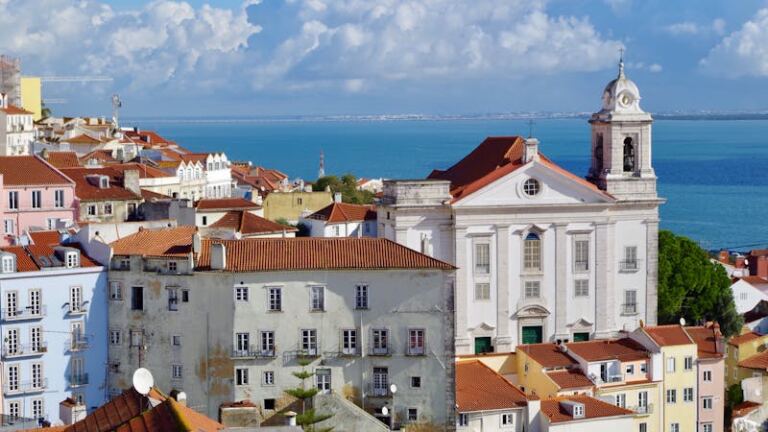Nice to Meet You in Portuguese: The Beginner’s Guide to Introductions
Science claims most people take 7 seconds to construct a first impression upon meeting someone else. This initial judgment can dictate what kind of relationship will result from the conversation. It also means you have less than the time it takes to drink a bica to make a great first impression.
The same applies to introductions in foreign languages. Moreover, in such cases, you must familiarize yourself with the cultural details of greeting someone for the first time. It is not about using translated sentences or common words.
Instead, it involves understanding each gesture and sign to ensure a good outcome. Anyone can translate Nice to meet you into Prazer em conhecê-lo. But not everyone can communicate like a local. So, you must learn to show respect to the natives while establishing a cordial interexchange.
Respecting the intricacies of a Portuguese introduction is essential to build new relationships. So, how should you say Nice to meet you in Portuguese?
In this lesson, discover the importance of a well-structured introduction. Understand the possibilities brought on by learning to greet people properly. Plus, explore the differences between different Portuguese-speaking cultures and avoid frequent mistakes.
Why Bother Learning Introductions?
Since most locals speak English, many claim it is worthless to explore the world of introductions in their Portuguese lessons. After all, isn’t it more convenient to use the same language from start to finish?
Still, if you don’t start with a simple greeting, how will you learn to maintain more complex discussions? And how will you feel more comfortable starting conversations in a language different from your mother tongue?
The truth is that introductions help you, as a student, to start practicing your Portuguese. They allow you the time and space to understand what gestures and facial expressions accompany the words. Besides, you can start feeling the satisfaction of using another language regardless of your fluency level.

Would you like to kickstart your European Portuguese studies? The Journey is an interactive course that emphasizes immersion through insightful lessons. This European Portuguese gamified experience helps you reach your language learning goals!
The Beginner’s Guide to Introductions in Portuguese
You might be starting your Portuguese studies or already have some knowledge of the language. Regardless, studying and improving your introductions is paramount. To begin, you must learn the standard greetings to show locals you are striving to respect their culture.
This attitude is a sure heart-warmer for most natives and an opportunity to put your Portuguese lessons into practice. You can adjust your words to the situation and the person you are interacting with. Besides, the Portuguese language allows you to be as simple or elaborate as you wish.
5 Ways to Say Hi
Regardless of having crossed paths before, the first word you use when meeting anyone is usually a greeting. It is a way to break the ice and a sign of politeness. In Portuguese, you can use:
- Bom dia/Boa tarde/Boa noite (Good morning/afternoon/evening): use these greetings based on the time of day.
- Olá (Hello): You can apply this simple word, similar to the Spanish Hola, like you would its English equivalent.
- Tudo bem? (How is it going?): Despite being a question, it also acts as a greeting among friends. Unfortunately, the Portuguese often inquire without expecting an answer.
- Boas (Hey): Only for informal situations, especially among colleagues, friends, and family.
- Oi (Hi): Originated in the Brazilian language but became common also in Portugal.
Using these greetings at a proper time and context, according to their meanings, is one of the critical aspects of a good introduction. Even if you don’t speak Portuguese, the locals will appreciate your effort to greet them in their language.
Look into how you can adapt to different levels of formality.
Formal Vs. Informal
As you probably already know, the levels of formality in Portuguese can be tricky. The natives value politeness, which involves knowing the proper way to relate to them and showing due respect. Discover more in the Ultimate Guide on How to Address a Portuguese.
Overall, you will find two forms of treatment. This distinction is a valuable aspect of the language. It reflects the social dynamics and respect for hierarchy prevalent in Portuguese culture.
When to Keep It Casual
The second person singular (Tu) applies to people you know well and are comfortable with. You can also use it in casual settings and with people your age or younger. In this case, to say Nice to meet you in Portuguese, you would say: Prazer em conhecer-te. You can also shorten this sentence to say just Prazer (Pleasure).
Afterward, you can complement it with a Tudo bem? (Everything okay?) or a Como estás? (How are you?). Note that these phrases show personal interest without demanding detailed answers. You can use them with a friend, colleague, or acquaintance to maintain a polite and relaxed dialogue.
The Time to Be Formal
Some situations require a higher level of formality than others. Besides, your motivation to learn Portuguese will dictate which situations you will face more often. Thus, it is best to prepare.

You can start with a greeting like Bom dia, Boa tarde, or Boa noite. Olá is also acceptable in most cases. In formal situations, the Portuguese don’t tend to use a specific pronoun. Instead, they conjugate the verb in the third person singular (Ele or Ela), creating a respectful distance.
You can follow the greeting with a Como vai? or Como está? (How are you?). Afterward, you can introduce yourself and wait for the other person to say their name or ask Como se chama? (What is your name?). Then, you say Prazer em conhecê-lo or conhecê-la, according to their gender. It is polite to use the name of the person throughout the conversation.
Despite its widespread use in Brazilian Portuguese, the word Você isn’t so well accepted in Portugal. You can learn more about this theme in Tu and Você – How to Say You in Portuguese.
Outside Portugal: The Portuguese Variants
Portuguese is the official language in nine states. Despite sharing the same language, each country has its characteristic expressions. These changes are most evident between the European and Brazilian varieties.
There are many differences between Brazilian Portuguese and its European counterpart. For example, the sentence Nice to meet you in Portuguese changes from one country to the other. In Brazil, you will hear Prazer em te conhecer, while in Portugal, it will be Prazer em conhecer-te.
The same goes for asking someone else’s name. In Portugal, you should say Como se chama? (literally, How are you called?), while in Brazil, you will use Qual é o seu nome? (What is your name?).
When you learn Portuguese, you also explore the differences between its variants. These details enrich your learning journey and allow you to dive deep into each culture.
Gestures and Body Language
About 70 to 93% of all communication is non-verbal. Gestures, facial expressions, and other signs change denote personalities but also cultures. Some gestures identify specific countries and people. Their unique meaning and characteristic usage make them symbols of such cultures.
Portugal is no exception. Understanding non-verbal communication can help you feel more comfortable when meeting new people. It is also a way of saying Nice to meet you in Portuguese.
As in most European cultures, maintaining natural eye contact is a polite form of consideration toward the other person. It shows interest in what they are saying and conveys trust. Additionally, a smile is always the perfect start to any meeting.
Formal encounters usually demand a firm handshake as an initial and final greeting. With both hands in sight, shake with your right hand, keeping it vertical while making eye contact and smiling warmly. Remember to remove your gloves before handshaking if you are wearing any.
For casual or more relaxed meetings, cheek kisses are acceptable. Still, you should maintain awareness of the other person’s cues to adjust your approach. Finally, it is not common practice among the Portuguese to hug in a first meeting. The same goes for when they have not established a close relationship yet.
The Portuguese are big on hand gestures and facial expressions. Here are the Top Gestures Used by Portuguese People.
Natives show excitement when discussing topics they are passionate about. You will notice it in their intonation and hand gestures. Yet, this excitement should be less intense in formal situations. The Portuguese maintain composure and a professional posture in business settings.
After The Introduction: Keep The Dialogue Flowing
A solid introduction is critical. But it is also the start of a dialogue you must carry on. After mutual inquiries on well-being and depending on your motivation to meet, it is polite to engage in some chit-chat. There are 3 points to care for:
- Learn Chit-Chat: Small talk can be a way to connect to the other person or approach a specific subject with subtlety. For example, work meetings require you to go straight to the point. Reducing introductory chat shows respect for the other person’s schedule.
However, circumstances change when meeting a potential practice buddy for the first time. You can start by discussing your language-learning story. Afterward, dive into what you both expect from the exchanges, how often you can meet, and other details.
- Ask The Right Questions: Develop the art of asking questions and listening intensively to understand others. This attitude will help you win over the locals. Besides, maintain a positive tone, even if you don’t agree with everything they say. Be sincere, but remain kind.
- Use Proper Vocabulary: Familiarize yourself with vocabulary related to what you will discuss. During the meeting, it will be easier to follow the dialogue. You will show interest, ask better questions, understand their answers, and add value to the conversation.
Do you want to learn all about the subtleties of conversation in Portuguese? Sign up for The Journey, our European Portuguese course. With unique features and science-based methods, it helps you reach fluency while having fun!
Common Mistakes to Avoid
- Pay Attention to False Friends: be cautious with words that sound similar but have different meanings. These terms can lead to avoidable misunderstandings and mishaps in communication. To learn more, read 18 European Portuguese False Cognates You Should Know, and watch 50 False Friends – Portuguese/English.
- Do Not Focus Too Much on Yourself: a conversation should allow space for all of its participants. So, listen attentively. It is an opportunity to develop your listening comprehension and connect more deeply with those you interact with.
- Master Non-verbal Communication: find the balance between overexcitement and apathy. Use natural gestures and adjust your volume and tone to others’ without mimicking their speaking style.
- Practice Pronunciation: Prepare ahead for your meeting. Investigate and practice the correct pronunciation of specific terms. Nailing those words helps you convey your points with more confidence.
- Do Not Fall Back Into English: most Portuguese natives speak English. So, when they see you struggling with some aspect of the language, they might switch to it to help you. However, it is up to you to tell them you would like to continue the conversation in Portuguese. Doing so, you will get more speaking practice and keep improving toward talking like a local.

Nice To Meet You in Portuguese – Your Intro to European Portuguese
A solid introduction can open many doors toward professional success and personal gratification. Learning how to greet people, show personal interest, and use common gestures helps you communicate like a local.
Understanding cultural details allows you to show respect and openness toward the person you interact with. What surprised you the most about how to say Nice to meet you in Portuguese? What differences have you noticed between introductions in Portuguese-speaking countries? Share your thoughts with us in the comments below!
Find more exclusive tips and tricks by following our social media channels. Discover insightful YouTube videos, captivating Instagram reels, and cultural Facebook posts. Join our community and immerse yourself in the Portuguese language!
Learning to introduce yourself and saying Nice to meet you in Portuguese is the first step toward reaching your language goals. But what is next? How can you continue progressing toward fluency?
Go Beyond Nice to meet you in Portuguese From Portugal
We developed a 30-day free program to get you started with European Portuguese. It includes articles, videos, and fun exercises to give you a solid grasp of the basics and the enthusiasm to continue learning.
Watch our video Learn Portuguese in 30 Days (Complete plan for FREE) to learn more about this mini-course. Additionally, read: Start Learning European Portuguese – Free 30-Day Plan.
You will not be fluent by the end of the month. However, you will have a reinforced vocabulary set and improved listening abilities. Furthermore, you will feel more confident to engage with the natives in conversation.
These resources will kickstart your Portuguese studies and help you speak naturally. You will dive into our beautiful language and get practical help to go beyond introductions in your new language. Start now!










